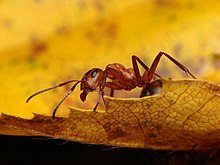| Formica polyctena | |
|---|---|

| |
| Scientific classification | |
| Domain: | Eukaryota |
| Kingdom: | Animalia |
| Phylum: | Arthropoda |
| Class: | Insecta |
| Order: | Hymenoptera |
| Family: | Formicidae |
| Subfamily: | Formicinae |
| Genus: | Formica |
| Species: | F. polyctena
|
| Binomial name | |
| Formica polyctena Förster, 1850
| |
Formica polyctena is a species of European red wood ant in the genus Formica and large family Formicidae. The species was first described by Arnold Förster in 1850. The latin species name polyctena is from Greek and literally means 'many cattle', referring to the species' habit of farming aphids for honeydew food.[2] It is found in many European countries. It is a eusocial species, that has a distinct caste system of sterile workers and a very small reproductive caste.[3] The ants have a genetic based cue that allow them to identify which other ants are members of their nest and which are foreign individuals.[4] When facing these types of foreign invaders the F. polyctena has a system to activate an alarm. It can release pheromones which can trigger an alarm response in other nearby ants.[5]
It is found in Austria, Belgium, Bulgaria, Czech Republic, Estonia, Finland, France, Germany, Hungary, Italy, Latvia, Lithuania, Luxembourg, the Netherlands, Norway, Poland, Romania, Russia, Serbia and Montenegro, Slovakia, Spain, Sweden, Switzerland, and Ukraine.[6]
- ^ Social Insects Specialist Group (1996). "Formica polyctena". IUCN Red List of Threatened Species. 1996: e.T8644A12924699. doi:10.2305/IUCN.UK.1996.RLTS.T8644A12924699.en. Retrieved 16 November 2021.
- ^ Mabelis, A. A. (1979). "Wood ant wars. The relationship between aggression and predation in the red wood ant (Formica polyctena Foerst.)". Netherlands Journal of Zoology. 29 (4): 451–620. doi:10.1163/002829679X00016.
- ^ Cite error: The named reference
Davieswas invoked but never defined (see the help page). - ^ Cite error: The named reference
Beyewas invoked but never defined (see the help page). - ^ Cite error: The named reference
Dumpertwas invoked but never defined (see the help page). - ^ Social Insects Specialist Group 1996
